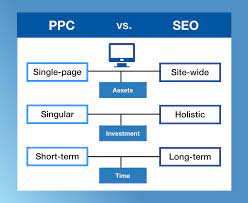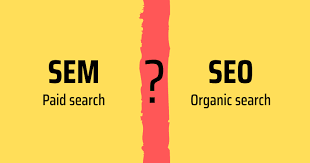Unlocking Success: The Impact of Search Engine Advertising on Your Business
The Power of Search Engine Advertising
Search engine advertising, also known as pay-per-click (PPC) advertising, is a powerful digital marketing strategy that allows businesses to promote their products and services on search engine results pages. With the majority of consumers turning to search engines like Google to find information, products, and services, search engine advertising presents a valuable opportunity for businesses to reach their target audience at the right moment.
How Does Search Engine Advertising Work?
Search engine advertising works on a pay-per-click model, where advertisers bid on specific keywords relevant to their target audience. When a user searches for a keyword that matches the advertiser’s bid, the ad is displayed prominently on the search results page. The advertiser only pays when a user clicks on the ad, making it a cost-effective way to drive targeted traffic to a website.
The Benefits of Search Engine Advertising
One of the key benefits of search engine advertising is its ability to target users who are actively searching for products or services related to the advertiser’s business. This high level of intent makes search engine advertising highly effective in driving conversions and generating leads.
Additionally, search engine advertising offers precise targeting options, allowing advertisers to reach specific demographics, locations, and devices. This level of control ensures that ads are shown to the most relevant audience, maximising the chances of engagement and conversion.
Measuring Success with Search Engine Advertising
Another advantage of search engine advertising is its robust tracking and analytics capabilities. Advertisers can measure key performance metrics such as click-through rate (CTR), conversion rate, and return on investment (ROI) to evaluate the effectiveness of their campaigns. This data-driven approach enables advertisers to make informed decisions and optimise their campaigns for better results.
Getting Started with Search Engine Advertising
If you’re looking to harness the power of search engine advertising for your business, it’s essential to start by conducting thorough keyword research and identifying your target audience. Creating compelling ad copy and landing pages that resonate with your audience is crucial for driving conversions.
Partnering with an experienced digital marketing agency can also help you navigate the complexities of search engine advertising and maximise your return on investment. With strategic planning and continuous optimisation, search engine advertising can be a game-changer for businesses looking to enhance their online visibility and drive growth.
Maximise Your Search Engine Advertising Success: 5 Essential Tips
- Use relevant keywords to target your audience effectively
- Create compelling ad copy to entice users to click on your ads
- Monitor and analyse your campaign performance regularly to make data-driven decisions
- Optimise your landing pages for better conversion rates
- Set a realistic budget and bid strategy to maximise ROI
Use relevant keywords to target your audience effectively
To maximise the effectiveness of your search engine advertising campaigns, it is crucial to use relevant keywords that resonate with your target audience. By selecting keywords that align closely with what your potential customers are searching for, you can increase the chances of your ads being shown to the right people at the right time. Effective keyword targeting not only enhances the visibility of your ads but also improves the quality of traffic directed to your website, ultimately leading to higher conversion rates and better return on investment.
Create compelling ad copy to entice users to click on your ads
Creating compelling ad copy is a crucial aspect of search engine advertising. Your ad copy serves as the first point of contact with potential customers, enticing them to click on your ads and learn more about your products or services. By crafting engaging and persuasive ad copy that resonates with your target audience, you can significantly increase the chances of driving clicks and conversions. A well-crafted ad copy not only captures attention but also conveys the value proposition of your offerings, ultimately encouraging users to take action and engage with your business.
Monitor and analyse your campaign performance regularly to make data-driven decisions
Monitoring and analysing your search engine advertising campaign performance regularly is crucial for making informed, data-driven decisions. By keeping a close eye on key metrics such as click-through rates, conversion rates, and return on investment, you can identify what’s working well and where adjustments may be needed. This data-driven approach allows you to optimise your campaigns effectively, allocate budget strategically, and ultimately maximise the impact of your advertising efforts. Regular monitoring ensures that you stay agile and responsive in the dynamic digital landscape, helping you achieve better results and drive continuous improvement in your search engine advertising strategies.
Optimise your landing pages for better conversion rates
Optimising your landing pages is a crucial tip for improving conversion rates in search engine advertising. By creating landing pages that are tailored to match the ad content and provide a seamless user experience, you can increase the likelihood of visitors taking desired actions, such as making a purchase or signing up for a service. Effective landing page optimisation involves clear and compelling calls-to-action, relevant and engaging content, fast loading times, and mobile responsiveness. By focusing on enhancing the user journey from ad click to conversion, you can maximise the effectiveness of your search engine advertising campaigns and drive better results for your business.
Set a realistic budget and bid strategy to maximise ROI
Setting a realistic budget and bid strategy is crucial when it comes to maximising return on investment (ROI) in search engine advertising. By carefully allocating your budget based on your business goals and target audience, you can ensure that your ad campaigns are cost-effective and yield optimal results. A strategic bid strategy that focuses on bidding for relevant keywords and adjusting bids based on performance can help you reach your desired audience while maximising the value of each click. Ultimately, a well-planned budget and bid strategy will not only help you achieve a higher ROI but also ensure that your advertising efforts align with your overall marketing objectives.


